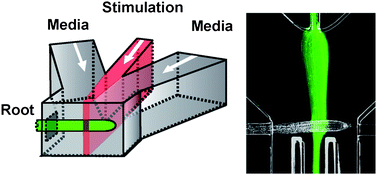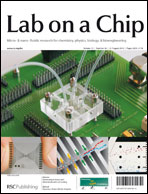In this article, we developed a “plant on a chip” microfluidic platform that can control the local chemical environment around live roots of Arabidopsis thaliana with high spatial resolution using multi-laminar flow. We characterized the flow profile around the Arabidopsis root, and verified that the shear forces within the device (∼10 dyne cm−2) did not impede growth of the roots. Our platform was able to deliver stimuli to the root at a spatial resolution of 10–800 µm. Further, the platform was validated by exposing desired regions of the root with a synthetic auxin derivative, 2,4-dichlorophenoxyacetic acid (2,4-D), and its inhibitor N-1-naphthylphthalamic acid (NPA). The response to the stimuli was observed using a DR5::GFP Arabidopsis line, where GFP expression is coupled to the auxin response regulator DR5. GFP expression in the root matched the position of the flow-focused stream containing 2,4-D. When the regions around the 2,4-D stimulus were exposed to the auxin transport inhibitor NPA, the active and passive transport mechanisms of auxin could be differentiated, as NPA blocks active cell-to-cell transport of auxin. Finally, we demonstrated that local 2,4-D stimulation in a ∼10 µm root segment enhanced morphological changes such as epidermal hair growth. These experiments were proof-of-concept and agreed with the results expected based on known root biology, demonstrating that this “root on a chip” platform can be used to test how root development is affected by any chemical component of interest, including nitrogen, phosphate, salts, and other plant hormones.


 Please wait while we load your content...
Please wait while we load your content...